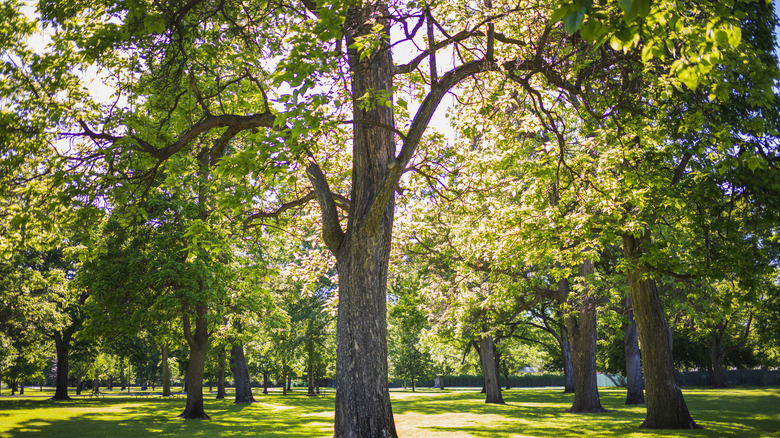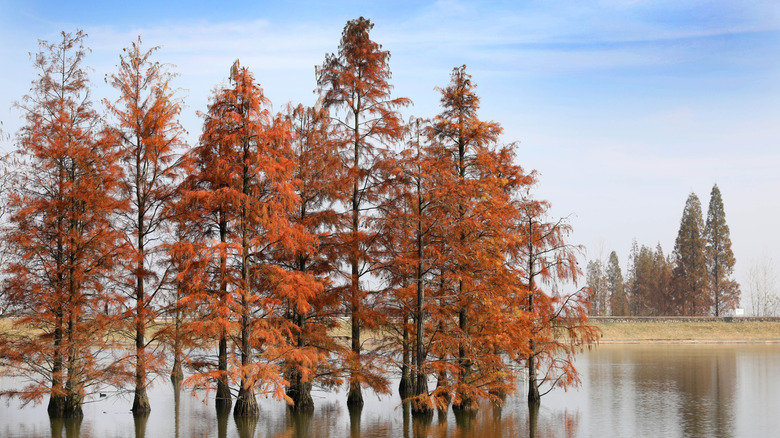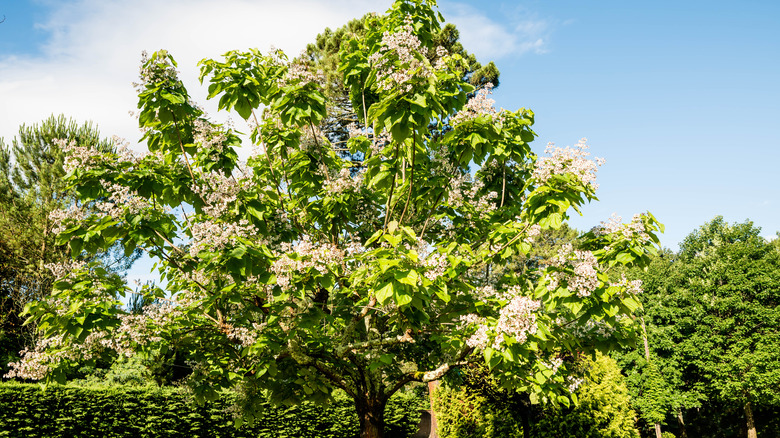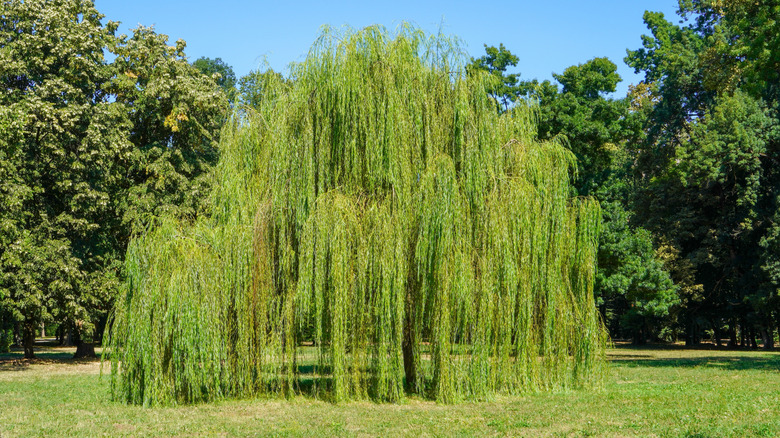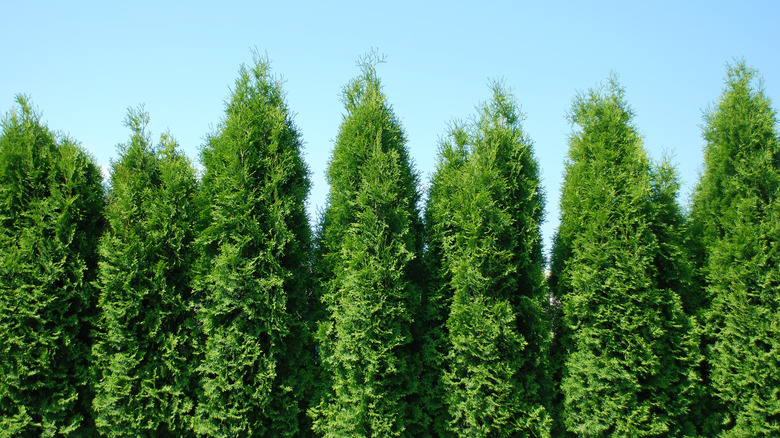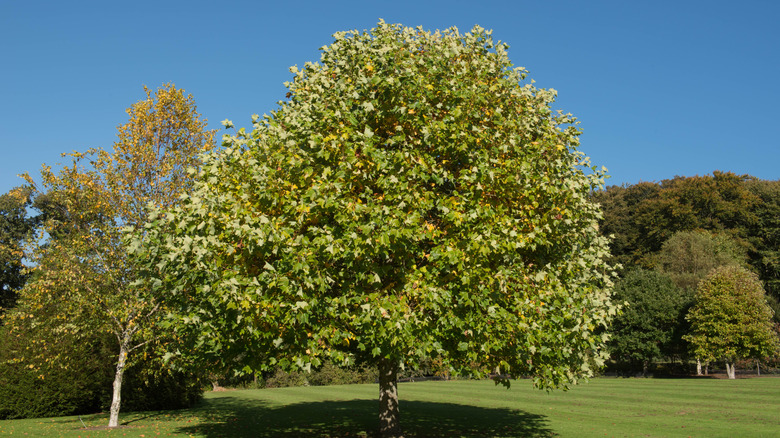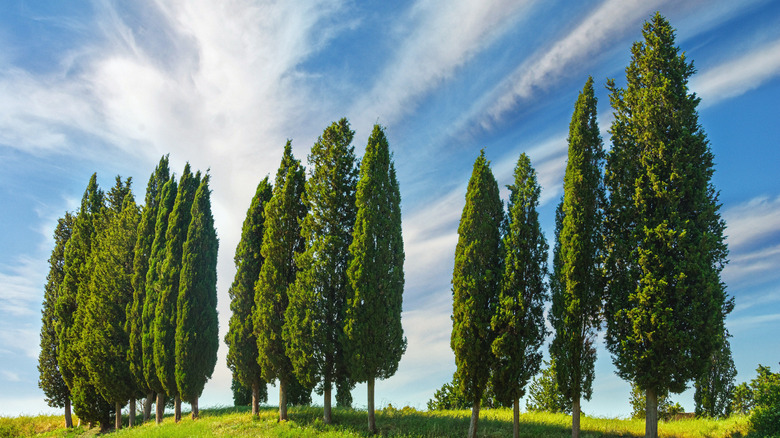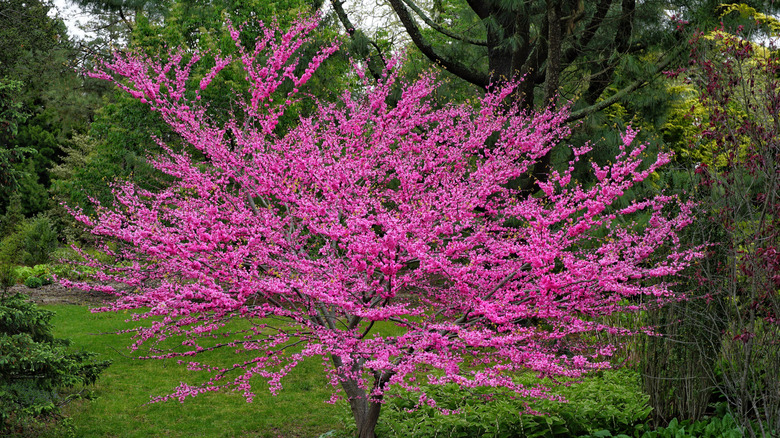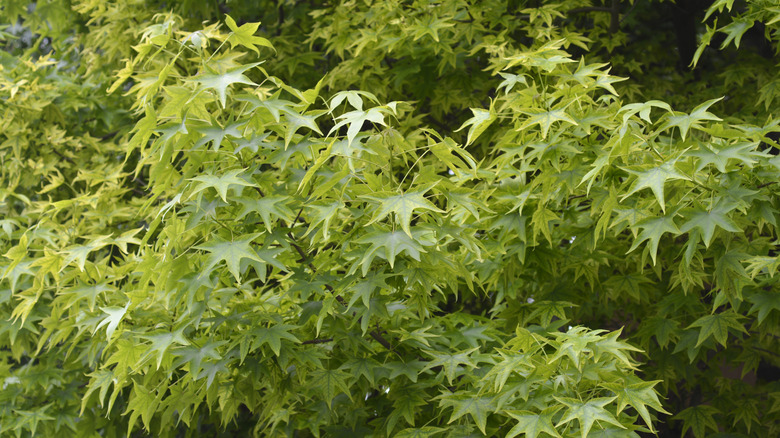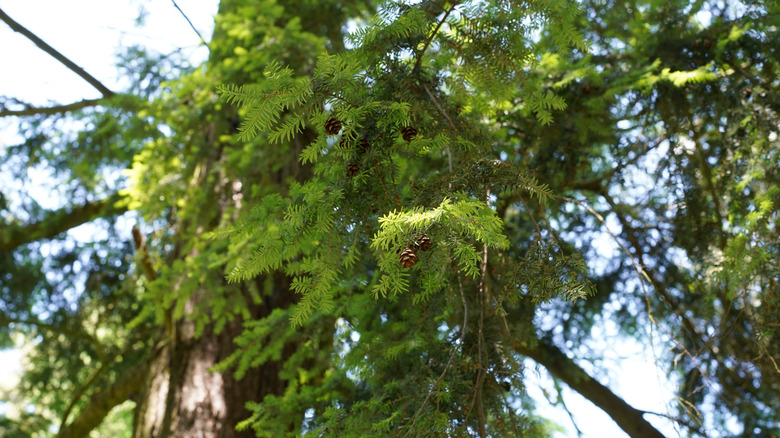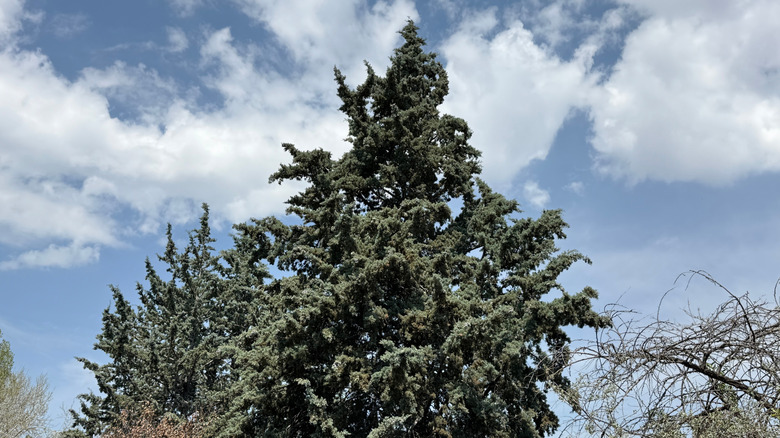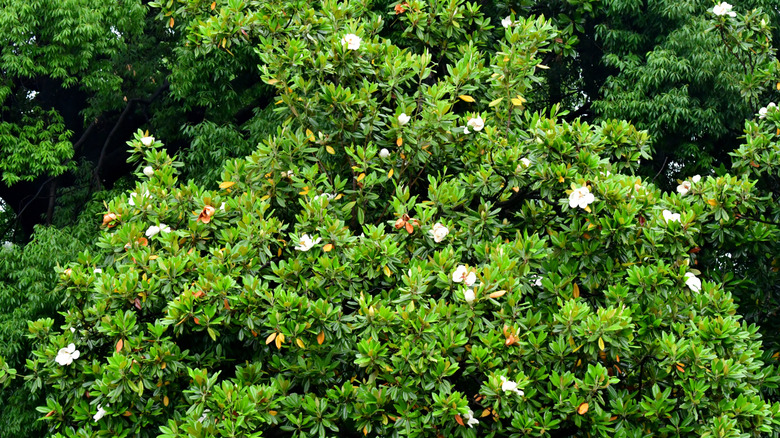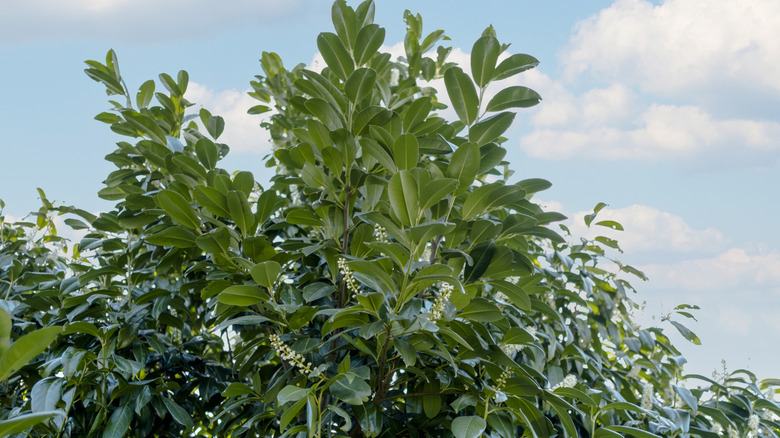16 Fast-Growing Trees That Will Add Privacy And Charm To Your Space
No matter how much you love your neighbors, you probably don't want them watching you sip coffee in your pajamas or host a backyard dinner. Privacy fences can help, but they can also feel a bit harsh or boxed in. That's where fast-growing trees come into — they're functional, beautiful, and far more inviting than a wall of concrete or wood.
The right tree can block out unwanted views, add cooling shade, and even bring birds and pollinators into your space. Whether you want something tall and dense like Thuja 'Green Giant' or Leyland cypress, or a more decorative choice like an eastern redbud or a southern magnolia, there's a tree on this list that'll fit your style and your climate.
Some of these trees, like black locust, grow surprisingly fast for hardwoods. Others, like weeping willow and Italian cypress, offer unique silhouettes that double as statement pieces. But the best part is that most of these trees are surprisingly low-maintenance once they're in the ground. So, you can enjoy a more private, peaceful, and beautiful yard without constant upkeep.
Dawn redwood
Once thought extinct and only known from fossils, the dawn redwood (Metasequoia glyptostroboides) was discovered in rural China sometime in the 1940s and is now beloved for its delicate leaves and rapid growth. This cone-shaped tree can reach up to 100 feet tall and 25 feet wide, making it perfect for large spaces in need of privacy. It thrives in sunlight and slightly acidic soil and is tolerant of wet conditions and urban pollution. It grows in USDA Hardiness Zones 4 through 8, and requires minimal maintenance.
Southern catalpa
Its curved branches sprawl in unpredictable directions, and its crushed leaves smell a bit funky, but the southern catalpa (Catalpa bignonioides)makes up for it with charm and character. Hardy in zones 5 through 9, this rapidly growing tree produces showy white flowers in early summer and long, dangling seed pods that give it a distinctive look. It thrives in full sun to part shade and handles everything from clay soil to flood waters during certain times of the year. It also supports beneficial moths that help feed birds and bats in your yard.
Weeping willow
Weeping willow (Salix babylonica) grows fast, looks dramatic, and causes just enough chaos to keep things interesting. Hardy in zones 6 through 8, it shoots up to 40 feet and loves wet spots — like pond edges or soggy lawns. Butterflies and bees love it, but homeowners might not. The roots invade pipes, the branches snap easily, and the mess is nonstop. Still, if you've got the space and the patience, this tree adds movement and mood to any landscape.
Thuja 'Green Giant'
If you want a living wall that grows like it means it, Thuja 'Green Giant' delivers. It gains 3 to 4 feet per year and tops out around 60 feet tall. You'll get dense, dark green foliage that stays lush year-round with barely any pruning. 'Green Giant' grows well in zones 5 through 8, and thrives in full sun. It can also handle drought and shrug off insects or deer. When it comes to caring for Thuja 'Green Giant', don't plant it near salty soil or ocean spray — it's not a beach fan.
Red oak
Red oak (Quercus rubra) is a rapidly growing hardwood that reaches up to 70 feet and delivers a fiery fall show with crimson-red leaves. It grows up to 2 feet a year in ideal conditions and handles urban environments like a champ. It grows best in zones 4 through 8 (much of North America) in well-drained soil and full sun. Its strong branching structure and long lifespan make it a smart pick for shade, wildlife, and year-round curb appeal. Just give it space because this isn't a tree that likes to be crowded.
Leyland cypress
Leyland cypress (Cuprocyparis leylandii) looks great early on and can live up to half a century, but it comes with baggage. In zones 6 to 10, it shoots up to 3 feet a year and can hit 50 feet in just 15 years. Its bluish green needles and neat shape make it popular for privacy. However, since its roots don't grow deep, the tree doesn't hold up well in extreme summer heat, and bigger ones often fall over. It's also prone to pests and disease and needs regular pruning.
Tulip tree
Tulip tree (Liriodendron tulipifera) grows quickly, looks striking, and definitely needs its space. Also called a yellow poplar, it can grow 90 feet tall with a straight trunk and almost no lower branches. It thrives in zones 5 to 9. Tulip-shaped yellow flowers with orange centers bloom in spring and draw in butterflies and hummingbirds. The tree thrives in full sun and moist, well-drained soil but doesn't like drought or compacted ground. Planting a tulip tree is a beautiful way to bring shade, color, and a bit of drama to the garden.
Italian cypress
For structure and drama, Italian cypress (Cupressus sempervirens) works as a statement. This tall, evergreen tree thrives in zones 7 to 9 andworks beautifully as a privacy row. It grows fast when young, then slows down with age. Once established, it handles drought well and needs little maintenance. Don't prune it if you want to keep that clean, column-like shape. It prefers at least six hours of sunlight and well-drained soil – poorly drained spots can lead to root rot. You might run into mites or bagworms, but nothing too high-maintenance considering the look you that you get.
Eastern redbud
Eastern redbud (Cercis canadensis) bursts into bloom just as winter ends in February, covering its bare branches, and even its trunk, in purple-pink flowers. In zones 4 to 9, it grows 20 to 30 feet tall and fits well into smaller yards. You'll get big, heart-shaped leaves, fall color that ranges from golden to yellow, and black seed pods. It prefers plenty of sunlight but tolerates some shade and well-draining soil. It's one of those trees that makes everything feel more cheerful, especially when it's the first thing to bloom.
Sweetgum
Sweetgum (Liquidambar styraciflua) brings height, color, and a little bit of chaos to the yard. It can grow over 70 feet tall and grows star-shaped leaves that turn red, orange, yellow, or purple in fall. It loves sunlight and well-drained soil but can handle clay and tough urban conditions, too. It is hardy in zones 5 through 10. However, it drops spiky seed balls that can be a pain to clean up. But if you don't mind the mess, it's a classic choice for shade and seasonal drama.
Eastern hemlock
Eastern hemlock (Tsuga canadensis) adds soft texture and year-round greenery to shaded spots. It grows best in zones 3 to 7 and prefers cool, moist, well-drained soil with partial shade, as it can struggle in too much heat or drought. You can shape it as a tall, graceful tree or prune it into a dense privacy hedge. Just keep an eye out for pests like the hemlock wooly adelgid, which is a common disease of hemlock trees that can weaken or kill them if left untreated.
Arizona cypress
Arizona cypress (Hesperocyparis arizonica) grows tall, broad, and surprisingly well in heat. It is hardy in zones 7 to 11, and reaches up to 60 feet. It grows best in full sun, drought, and sandy or sloped soil with ease. Its silvery-blue foliage stays colorful year-round, making it a solid pick for windbreaks and privacy screens. Just make sure the trees are planted 7 feet apart. It's low-maintenance, fairly deer-resistant, and rarely fussy. Although, keep in mind that it can get canker, which may weaken its structure and affect how it looks over time.
Southern magnolia
Southern magnolia (Magnolia grandiflora) is a tall evergreen that grows best in zones 6 to 10. It reaches 60 to 80 feet with a wide, rounded crown and thick branches that often stay full to the ground. It needs space to grow and does best in fertile soil with some shade. Large, white flowers appear in summer and give off a strong scent. The tree also produces brown fruits with red seeds. It handles moisture, but not soggy soil or flooding. With a lifespan of up to 120 years, it brings lasting charm to any landscape.
Loquat tree
Loquat (Eriobotrya japonica) grows as a compact evergreen with coarse, wrinkled leaves and white blooms that appear once late fall sets in and all through winter. It grows best in zones 8 to 11 and can survive temperatures as low as 10 degrees Fahrenheit, but flowers and fruit usually won't make it if it drops below 28 degrees Fahrenheit. It prefers full sun and damp, well-drained soil, but handles drought and part shade too. Bees and hummingbirds visit its flowers, and its thick form works perfectly for screening.
Cherry laurel
Cherry laurel (Prunus laurocerasus) grows fast, stays green year-round, and forms a thick, leafy wall that's ideal for tall hedges or screening in shaded spots. This charming tree reaches 10 to 20 feet high and spreads about 8 to 10 feet wide. It handles barren soil, poor conditions, and intensive pruning without much trouble. In spring, the tree puts out small white flowers, even under a lot of shade. It grows best in zones 6 to 8 and may deal with some disease issues, but it's still a strong pick for coverage.
Black locust
If you're dealing with poor soil or a hard-to-fill area, and want a tree with fast growth, black locust (Robinia pseudoacacia) is a solid pick. It grows 30 to 50 feet tall, spreads up to 35 feet, and thrives in zones 3 to 8. It has no problem with drought or poor soil. In the seasons of spring and summer, it puts on a show with white, fragrant flowers, then drops long seed pods that stick around well into fall. But it has become invasive in parts of the Midwest, so plant with care in those regions.
